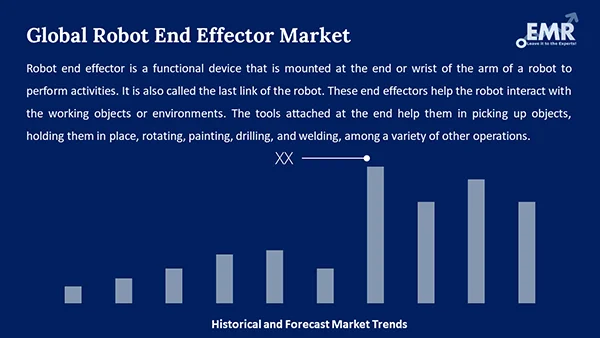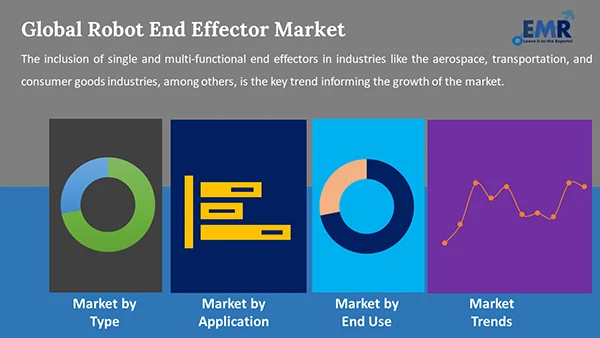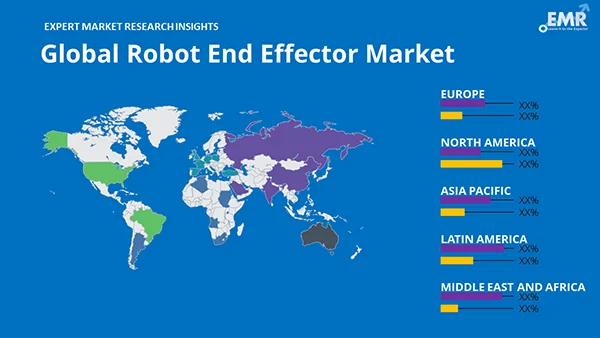Reports
Sale

Global Robot End Effector Market Analysis, Growth, Trends: By Type: Grippers, Clamps, Suction Cups, Welding Torch/Guns, Tool Changers, Others; By Application: Handling, Assembly, Welding, Dispensing, Processing, Others; By End Use: Automotive, Food and Beverage, Others; Regional Analysis; Competitive Landscape; 2024-2032
Global Robot End Effector Market Outlook
The global robot end effector market is expected to grow at a CAGR of about 15% in the forecast period of 2024-2032 to reach a value of around USD 15.04 billion by 2032.

Read more about this report - REQUEST FREE SAMPLE COPY IN PDF
China is Emerging as a Lucrative Market for Robot End Effectors
The increased automation and the growing adoption of artificial intelligence (AI) across the globe is increasing the robotic density across sectors, which has been propelling the demand for robot end effector. China, especially, has emerged as a major market for robot end effector. China, with its Made in China Plan, is set to become a manufacturing hub and is expected to subsequently use automation for the same, making it a lucrative market for end effectors. The region is projected to grow at a robust pace as compared to the more mature markets like North America and Europe. South Korea and Singapore are also projected to contribute significantly to the market growth as the countries extensively use robots in their manufacturing processes.
Robot End Effector: Market Segmentation
Robot end effector is a functional device that is mounted at the end or wrist of the arm of a robot to perform activities. It is also called the last link of the robot. These end effectors help the robot interact with the working objects or environments. The tools attached at the end help them in picking up objects, holding them in place, rotating, painting, drilling, and welding, among a variety of other operations.

Read more about this report - REQUEST FREE SAMPLE COPY IN PDF
Based on the types, the market can be divided into:
- Grippers
- Clamps
- Suction Cups
- Welding Torch/Guns
- Tool Changers
- Others
On the basis of application, the market is segmented into:
- Handling
- Assembly
- Welding
- Dispensing
- Processing
- Others
Robot end effector finds its major end uses in:
- Automotive
- Food and Beverage
- Pharmaceutical
- E-Commerce
- Metals and Machinery
- Electrical and Electronics
- Others
The regional markets for global robot end effector can be divided into North America, Europe, the Asia Pacific, Latin America, and the Middle East and Africa.

Read more about this report - REQUEST FREE SAMPLE COPY IN PDF
Increased Automation to Bolster the Market Growth of Robot End Effector
The use of automated machines or robots is increasing robustly as a lot of the tasks in the industries are being performed by machines or robots for higher efficiency. This is propelling the demand for robot end effectors as they are crucial for performing any task that the robot has been programmed to do. Grippers help to pick up and hold objects, clamps help in holding and securing the work tightly during fixturing and testing, welding, assembly, plastic injection moulding, and rotary indexers help in starting and stopping a device in definite intervals at accurate locations, and others are used in a variety of industries from aerospace, automotive, food and packaging, to industrial and consumer goods. Office robots are also being developed around the world to perform tasks that will need end effectors. Additionally, multi-purpose as well as single end effectors are also witnessing heightened demand. From aerospace, transportation, life science to the consumer goods industry, each have robotic installations for tasks like warehousing, assembling, moving, holding, and cutting, among others. Even making an advertisement for consumer goods involves technical machines that need to move, shift, or rotate the material in a certain way to get the perfect shot. Therefore, automation is boosting the demand for robot end effectors and is expected to continue to support the growth of the robot end effector industry.
Key Industry Players in the Global Robot End Effector Market
The report gives a detailed analysis of the following key players in the global robot end effector market, covering their competitive landscape, capacity, and latest developments like mergers, acquisitions, and investments, expansions of capacity, and plant turnarounds:
- ABB Group
- SCHUNK GmbH & Co. KG
- KUKA AG
- EMI Corporation
- ATI Industrial Automation, Inc.
- Others
The comprehensive EMR report provides an in-depth assessment of the market based on the Porter's five forces model along with giving a SWOT analysis.
Key Highlights of the Report
| REPORT FEATURES | DETAILS |
| Base Year | 2023 |
| Historical Period | 2018-2023 |
| Forecast Period | 2024-2032 |
| Scope of the Report |
Historical and Forecast Trends, Industry Drivers and Constraints, Historical and Forecast Market Analysis by Segment:
|
| Breakup by Type |
|
| Breakup by Application |
|
| Breakup by End Use |
|
| Breakup by Region |
|
| Market Dynamics |
|
| Competitive Landscape |
|
| Companies Covered |
|
| Report Price and Purchase Option | Explore our purchase options that are best suited to your resources and industry needs. |
| Delivery Format | Delivered as an attached PDF and Excel through email, with an option of receiving an editable PPT, according to the purchase option. |
*At Expert Market Research, we strive to always give you current and accurate information. The numbers depicted in the description are indicative and may differ from the actual numbers in the final EMR report.
1 Preface
2 Report Coverage – Key Segmentation and Scope
3 Report Description
3.1 Market Definition and Outlook
3.2 Properties and Applications
3.3 Market Analysis
3.4 Key Players
4 Key Assumptions
5 Executive Summary
5.1 Overview
5.2 Key Drivers
5.3 Key Developments
5.4 Competitive Structure
5.5 Key Industrial Trends
6 Snapshot
6.1 Global
6.2 Regional
7 Opportunities and Challenges in the Market
8 Global Robot End Effector Market Analysis
8.1 Key Industry Highlights
8.2 Global Robot End Effector Historical Market (2018-2023)
8.3 Global Robot End Effector Market Forecast (2024-2032)
8.4 Global Robot End Effector Market by Type
8.4.1 Grippers
8.4.1.1 Historical Trend (2018-2023)
8.4.1.2 Forecast Trend (2024-2032)
8.4.2 Clamps
8.4.2.1 Historical Trend (2018-2023)
8.4.2.2 Forecast Trend (2024-2032)
8.4.3 Suction Cups
8.4.3.1 Historical Trend (2018-2023)
8.4.3.2 Forecast Trend (2024-2032)
8.4.4 Welding Torch/Guns
8.4.4.1 Historical Trend (2018-2023)
8.4.4.2 Forecast Trend (2024-2032)
8.4.5 Tool Changers
8.4.5.1 Historical Trend (2018-2023)
8.4.5.2 Forecast Trend (2024-2032)
8.4.6 Others
8.5 Global Robot End Effector Market by Application
8.5.1 Handling
8.5.1.1 Historical Trend (2018-2023)
8.5.1.2 Forecast Trend (2024-2032)
8.5.2 Assembly
8.5.2.1 Historical Trend (2018-2023)
8.5.2.2 Forecast Trend (2024-2032)
8.5.3 Welding
8.5.3.1 Historical Trend (2018-2023)
8.5.3.2 Forecast Trend (2024-2032)
8.5.4 Dispensing
8.5.4.1 Historical Trend (2018-2023)
8.5.4.2 Forecast Trend (2024-2032)
8.5.5 Processing
8.5.5.1 Historical Trend (2018-2023)
8.5.5.2 Forecast Trend (2024-2032)
8.5.6 Others
8.6 Global Robot End Effector Market by End Use
8.6.1 Automotive
8.6.1.1 Historical Trend (2018-2023)
8.6.1.2 Forecast Trend (2024-2032)
8.6.2 Food and Beverage
8.6.2.1 Historical Trend (2018-2023)
8.6.2.2 Forecast Trend (2024-2032)
8.6.3 Pharmaceutical
8.6.3.1 Historical Trend (2018-2023)
8.6.3.2 Forecast Trend (2024-2032)
8.6.4 E-Commerce
8.6.4.1 Historical Trend (2018-2023)
8.6.4.2 Forecast Trend (2024-2032)
8.6.5 Metals and Machinery
8.6.5.1 Historical Trend (2018-2023)
8.6.5.2 Forecast Trend (2024-2032)
8.6.6 Electrical and Electronics
8.6.6.1 Historical Trend (2018-2023)
8.6.6.2 Forecast Trend (2024-2032)
8.6.7 Others
8.7 Global Robot End Effector Market by Region
8.7.1 North America
8.7.1.1 Historical Trend (2018-2023)
8.7.1.2 Forecast Trend (2024-2032)
8.7.2 Europe
8.7.2.1 Historical Trend (2018-2023)
8.7.2.2 Forecast Trend (2024-2032)
8.7.3 Asia Pacific
8.7.3.1 Historical Trend (2018-2023)
8.7.3.2 Forecast Trend (2024-2032)
8.7.4 Latin America
8.7.4.1 Historical Trend (2018-2023)
8.7.4.2 Forecast Trend (2024-2032)
8.7.5 Middle East and Africa
8.7.5.1 Historical Trend (2018-2023)
8.7.5.2 Forecast Trend (2024-2032)
9 North America Robot End Effector Market Analysis
9.1 United States of America
9.1.1 Historical Trend (2018-2023)
9.1.2 Forecast Trend (2024-2032)
9.2 Canada
9.2.1 Historical Trend (2018-2023)
9.2.2 Forecast Trend (2024-2032)
10 Europe Robot End Effector Market Analysis
10.1 United Kingdom
10.1.1 Historical Trend (2018-2023)
10.1.2 Forecast Trend (2024-2032)
10.2 Germany
10.2.1 Historical Trend (2018-2023)
10.2.2 Forecast Trend (2024-2032)
10.3 France
10.3.1 Historical Trend (2018-2023)
10.3.2 Forecast Trend (2024-2032)
10.4 Italy
10.4.1 Historical Trend (2018-2023)
10.4.2 Forecast Trend (2024-2032)
10.5 Others
11 Asia Pacific Robot End Effector Market Analysis
11.1 China
11.1.1 Historical Trend (2018-2023)
11.1.2 Forecast Trend (2024-2032)
11.2 Japan
11.2.1 Historical Trend (2018-2023)
11.2.2 Forecast Trend (2024-2032)
11.3 India
11.3.1 Historical Trend (2018-2023)
11.3.2 Forecast Trend (2024-2032)
11.4 ASEAN
11.4.1 Historical Trend (2018-2023)
11.4.2 Forecast Trend (2024-2032)
11.5 Australia
11.5.1 Historical Trend (2018-2023)
11.5.2 Forecast Trend (2024-2032)
11.6 Others
12 Latin America Robot End Effector Market Analysis
12.1 Brazil
12.1.1 Historical Trend (2018-2023)
12.1.2 Forecast Trend (2024-2032)
12.2 Argentina
12.2.1 Historical Trend (2018-2023)
12.2.2 Forecast Trend (2024-2032)
12.3 Mexico
12.3.1 Historical Trend (2018-2023)
12.3.2 Forecast Trend (2024-2032)
12.4 Others
13 Middle East and Africa Robot End Effector Market Analysis
13.1 Saudi Arabia
13.1.1 Historical Trend (2018-2023)
13.1.2 Forecast Trend (2024-2032)
13.2 United Arab Emirates
13.2.1 Historical Trend (2018-2023)
13.2.2 Forecast Trend (2024-2032)
13.3 Nigeria
13.3.1 Historical Trend (2018-2023)
13.3.2 Forecast Trend (2024-2032)
13.4 South Africa
13.4.1 Historical Trend (2018-2023)
13.4.2 Forecast Trend (2024-2032)
13.5 Others
14 Market Dynamics
14.1 SWOT Analysis
14.1.1 Strengths
14.1.2 Weaknesses
14.1.3 Opportunities
14.1.4 Threats
14.2 Porter’s Five Forces Analysis
14.2.1 Supplier’s Power
14.2.2 Buyer’s Power
14.2.3 Threat of New Entrants
14.2.4 Degree of Rivalry
14.2.5 Threat of Substitutes
14.3 Key Indicators for Demand
14.4 Key Indicators for Price
15 Value Chain Analysis
16 Competitive Landscape
16.1 Market Structure
16.2 Company Profiles
16.2.1 ABB Group
16.2.1.1 Company Overview
16.2.1.2 Product Portfolio
16.2.1.3 Demographic Reach and Achievements
16.2.1.4 Certifications
16.2.2 SCHUNK GmbH & Co. KG
16.2.2.1 Company Overview
16.2.2.2 Product Portfolio
16.2.2.3 Demographic Reach and Achievements
16.2.2.4 Certifications
16.2.3 KUKA AG
16.2.3.1 Company Overview
16.2.3.2 Product Portfolio
16.2.3.3 Demographic Reach and Achievements
16.2.3.4 Certifications
16.2.4 EMI Corporation
16.2.4.1 Company Overview
16.2.4.2 Product Portfolio
16.2.4.3 Demographic Reach and Achievements
16.2.4.4 Certifications
16.2.5 ATI Industrial Automation, Inc.
16.2.5.1 Company Overview
16.2.5.2 Product Portfolio
16.2.5.3 Demographic Reach and Achievements
16.2.5.4 Certifications
16.2.6 Others
17 Key Trends and Developments in the Market
List of Key Figures and Tables
1. Global Robot End Effector Market: Key Industry Highlights, 2018 and 2032
2. Global Robot End Effector Historical Market: Breakup by Type (USD Billion), 2018-2023
3. Global Robot End Effector Market Forecast: Breakup by Type (USD Billion), 2024-2032
4. Global Robot End Effector Historical Market: Breakup by Application (USD Billion), 2018-2023
5. Global Robot End Effector Market Forecast: Breakup by Application (USD Billion), 2024-2032
6. Global Robot End Effector Historical Market: Breakup by End Use (USD Billion), 2018-2023
7. Global Robot End Effector Market Forecast: Breakup by End Use (USD Billion), 2024-2032
8. Global Robot End Effector Historical Market: Breakup by Region (USD Billion), 2018-2023
9. Global Robot End Effector Market Forecast: Breakup by Region (USD Billion), 2024-2032
10. North America Robot End Effector Historical Market: Breakup by Country (USD Billion), 2018-2023
11. North America Robot End Effector Market Forecast: Breakup by Country (USD Billion), 2024-2032
12. Europe Robot End Effector Historical Market: Breakup by Country (USD Billion), 2018-2023
13. Europe Robot End Effector Market Forecast: Breakup by Country (USD Billion), 2024-2032
14. Asia Pacific Robot End Effector Historical Market: Breakup by Country (USD Billion), 2018-2023
15. Asia Pacific Robot End Effector Market Forecast: Breakup by Country (USD Billion), 2024-2032
16. Latin America Robot End Effector Historical Market: Breakup by Country (USD Billion), 2018-2023
17. Latin America Robot End Effector Market Forecast: Breakup by Country (USD Billion), 2024-2032
18. Middle East and Africa Robot End Effector Historical Market: Breakup by Country (USD Billion), 2018-2023
19. Middle East and Africa Robot End Effector Market Forecast: Breakup by Country (USD Billion), 2024-2032
20. Global Robot End Effector Market Structure
The global robot end effector market is projected to grow at a CAGR of 15% between 2024 and 2032.
The market is estimated to witness a robust growth in the forecast period of 2024-2032 to reach nearly USD 15.04 billion by 2032.
The increasing adoption of artificial intelligence and automation and surging manufacturing capabilities in the emerging economies are the major market drivers.
The key trends propelling the market include the growing inclusion of single and multi-functional end effectors in diverse end-use sectors and the rising use of automated machines in various applications.
The major regions in the market are North America, Europe, the Asia Pacific, Latin America, and the Middle East and Africa.
The leading types of robot end effectors in the market are grippers, clamps, suction cups, welding torch/guns, and tool changers, among others.
The significant applications of robot end effectors are handling, assembly, welding, dispensing, and processing, among others.
The various end uses of the product are automotive, food and beverage, pharmaceutical, e-commerce, metals and machinery, and electrical and electronics, among others.
The major players in the market are ABB Group, SCHUNK GmbH & Co. KG, KUKA AG, EMI Corporation, and ATI Industrial Automation, Inc., among others.
The global robot end effector market is being driven by the rising penetration of automation in every industry. Aided by the growth of artificial intelligence, the market is expected to witness a robust growth in the forecast period of 2024-2032, growing at a CAGR of 15%. The market is projected to reach about USD 15.04 billion by 2032.
EMR’s meticulous research methodology delves deep into the market, covering the macro and micro aspects of the industry. Based on types, the market can be segmented into grippers, clamps, suction cups, welding torch/guns, tool changers, and others. The robot end effector’s application includes handling, assembly, welding, dispensing, and processing, among others. Based on end uses, the market is divided into automotive, food and beverage, pharmaceutical, e-commerce, metals and machinery, and electrical and electronics, among others. The major regional markets of robot end effector are North America, Europe, the Asia Pacific, Latin America, and the Middle East and Africa. The key players in the above market are ABB Group, SCHUNK GmbH & Co. KG, KUKA AG, EMI Corporation, ATI Industrial Automation, Inc., and others.
EMR’s research methodology uses a combination of cutting-edge analytical tools and the expertise of their highly accomplished team, thus, providing their customers with market insights that are accurate, actionable, and help them remain ahead of their competition.
Mini Report
-
Selected Sections, One User
-
Printing Not Allowed
-
Email Delivery in PDF
-
Free Limited Customisation -
Post Sales Analyst Support -
50% Discount on Next Update
Single User License
-
All Sections, One User
-
One Print Allowed
-
Email Delivery in PDF
-
Free Limited Customisation -
Post Sales Analyst Support -
50% Discount on Next Update

Five User License
-
All Sections, Five Users
-
Five Prints Allowed
-
Email Delivery in PDF
-
Free Limited Customisation
-
Post Sales Analyst Support
-
50% Discount on Next Update
Corporate License
-
All Sections, Unlimited Users
-
Unlimited Prints Allowed
-
Email Delivery in PDF + Excel
-
Free Limited Customisation
-
Post Sales Analyst Support
-
50% Discount on Next Update
Any Question? Speak With An Analyst
View A Sample
Did You Miss Anything, Ask Now
Right People
We are technically excellent, strategic, practical, experienced and efficient; our analysts are hand-picked based on having the right attributes to work successfully and execute projects based on your expectations.
Right Methodology
We leverage our cutting-edge technology, our access to trusted databases, and our knowledge of the current models used in the market to deliver you research solutions that are tailored to your needs and put you ahead of the curve.
Right Price
We deliver in-depth and superior quality research in prices that are reasonable, unmatchable, and shows our understanding of your resource structure. We, additionally, offer attractive discounts on our upcoming reports.
Right Support
Our team of expert analysts are at your beck and call to deliver you optimum results that are customised to meet your precise needs within the specified timeframe and help you form a better understanding of the industry.


